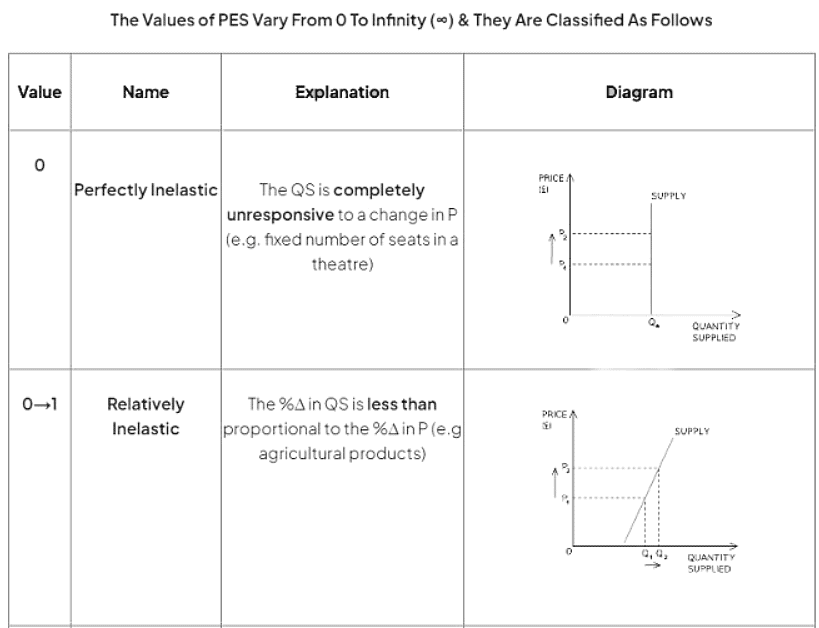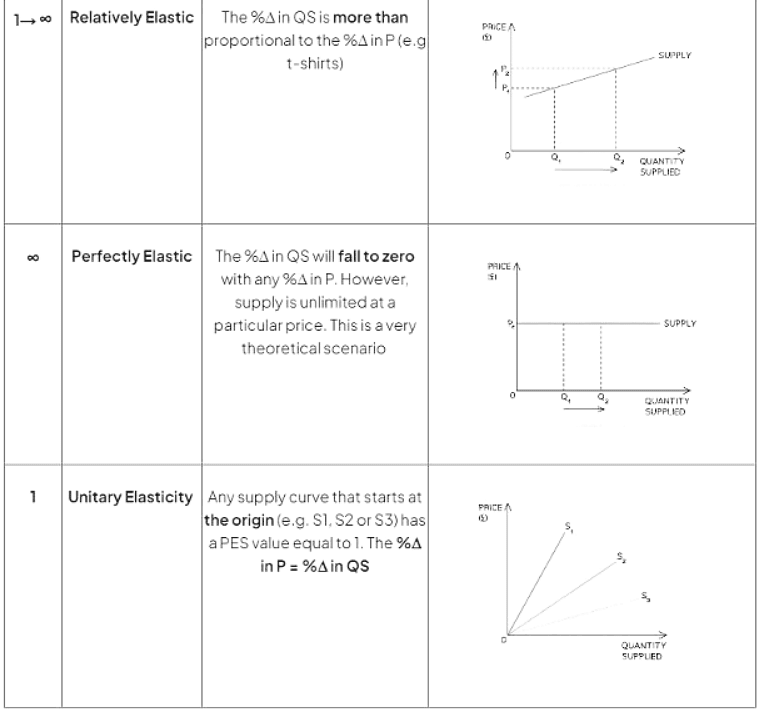Year 11 Exam > Year 11 Notes > Economics for GCSE/IGCSE > Calculation, Determinants & Significance of PES
Calculation, Determinants & Significance of PES | Economics for GCSE/IGCSE - Year 11 PDF Download
| Table of contents |

|
| The Definition & Calculation of PES |

|
| Interpretation of PES Value |

|
| The Determinants of PES |

|
| The Significance of Price Elasticity of Supply (PES) for Stakeholders |

|
The Definition & Calculation of PES
- The law of supply stipulates that with a price increase (assuming other factors remain constant), producers will boost the quantity supplied, and conversely.
- Economists focus on gauging the extent of the increase in quantity supplied.
- Price elasticity of supply (PES) indicates the degree of responsiveness of quantity supplied to price changes.
- This responsiveness varies across distinct product categories.
To calculate PES
- PES can be calculated using the formula:

- To calculate a percentage change:

Interpretation of PES Value


Question for Calculation, Determinants & Significance of PESTry yourself: What does the price elasticity of supply (PES) measure?View Solution
The Determinants of PES
- Certain products exhibit greater responsiveness to price changes compared to others.
- The factors influencing this responsiveness are referred to as the determinants of Price Elasticity of Supply (PES) and comprise:
- Mobility of Factors of Production: This refers to how easily producers can switch their resources between different products. When producers can quickly adapt, PES tends to be more elastic. For instance, if the price of hiking boots rises, and shoe manufacturers can readily shift resources from making trainers to boots, the supply of boots becomes more price elastic.
- Availability of Raw Materials: The scarcity or abundance of raw materials plays a crucial role in determining PES. When raw materials are scarce, PES is low or inelastic. Conversely, if raw materials are abundant, PES is higher or elastic.
- Ability to Store Goods: Products that can be easily stored typically exhibit higher PES. For example, goods like tinned food products have higher elasticity in supply because producers can quickly increase supply when needed. On the other hand, products with limited storage capabilities have lower PES.
- Spare Capacity: If there is excess capacity in factories producing certain goods, an increase in prices can lead to elastic supply. Conversely, if there is no spare capacity to ramp up production, the supply will be inelastic.
- Time Period: In the short run, it may be challenging for producers to respond to price increases due to production constraints. For instance, products like avocados have a longer production cycle. However, in the long run, producers can adjust their factors of production to increase output.
The Significance of Price Elasticity of Supply (PES) for Stakeholders
- Understanding High and Low PES:
- If producers have a high PES (elastic), they can quickly adapt to price changes. This agility allows them to boost revenues and profits by supplying more goods.
- On the contrary, low PES (inelastic) indicates a slow response to price shifts, leading to persistent price hikes and potential inflation in the economy.
- Government Interest in PES:
- Governments closely monitor the PES of critical markets to ensure prompt responses to increasing demand.
- For instance, in the housing market, low PES can make property prices unaffordable with rising demand.
- Similarly, in the labor market, low PES can swiftly escalate production costs for firms when hiring additional workers becomes necessary.
- Factors Influencing PES:
- Producers can enhance their PES by creating surplus production capacity, maintaining larger inventories, and adopting advanced technologies.
The document Calculation, Determinants & Significance of PES | Economics for GCSE/IGCSE - Year 11 is a part of the Year 11 Course Economics for GCSE/IGCSE.
All you need of Year 11 at this link: Year 11
|
71 videos|82 docs|39 tests
|
FAQs on Calculation, Determinants & Significance of PES - Economics for GCSE/IGCSE - Year 11
| 1. What is the definition of Price Elasticity of Supply (PES)? |  |
Ans. Price Elasticity of Supply (PES) measures the responsiveness of quantity supplied to a change in price. It is calculated as the percentage change in quantity supplied divided by the percentage change in price.
| 2. How is Price Elasticity of Supply (PES) calculated? |  |
Ans. PES is calculated by taking the percentage change in quantity supplied and dividing it by the percentage change in price. The formula is: PES = (% Change in Quantity Supplied) / (% Change in Price).
| 3. What are the determinants of Price Elasticity of Supply (PES)? |  |
Ans. The determinants of PES include the availability of inputs, time period considered, ease of production, and flexibility of resources. If producers can easily adjust production in response to price changes, PES is likely to be higher.
| 4. How is the interpretation of the PES value done? |  |
Ans. A PES value of greater than 1 indicates that supply is elastic, meaning that producers can quickly adjust output in response to price changes. A PES value of less than 1 signifies inelastic supply, where producers are unable to adjust output easily.
| 5. Why is Price Elasticity of Supply (PES) significant for stakeholders? |  |
Ans. PES is important for stakeholders as it helps them understand how sensitive the quantity supplied is to changes in price. This information can guide decision-making, production planning, and pricing strategies for businesses, policymakers, and consumers.
Related Searches

















